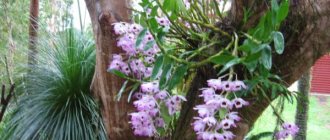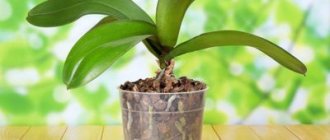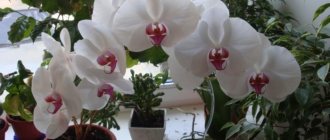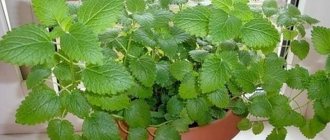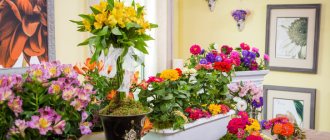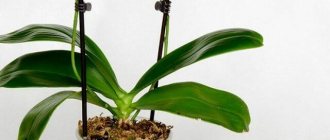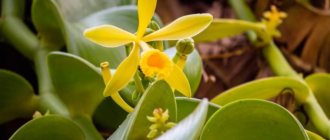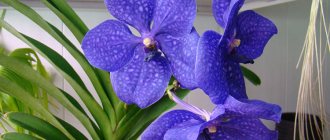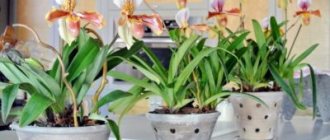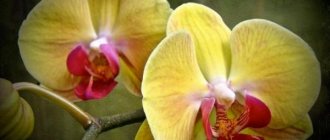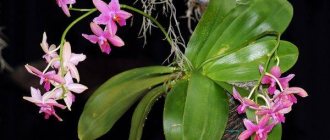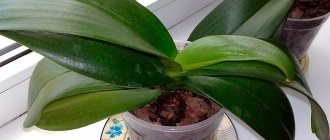Oncidium is a member of the Orchid family. This is an epiphyte that has many species. All of them are easy to distinguish from each other, since they have different leaves and inflorescences.
The first species grow in the tropical forests of the American continent, others have adapted to mountain climates with lower air temperatures. Still others preferred living in savannas.
Planting and caring for oncidium
- Flowering: once every 9-12 months for 4-5 weeks. Hybrid varieties can bloom 2-3 times a year.
- Lighting: bright sunlight with shading in the afternoon - eastern and western window sills are suitable for the plant. In winter, if the orchid is about to bloom, you will have to provide it with additional artificial lighting.
- Temperature: depending on the type: in summer from 20 to 30 ˚C, in winter – from 7 to 18 ˚C. For the most part, hybrids go on sale that can develop and bloom normally in the temperature range from 14 to 26 ˚C, subject to a difference between night and day temperatures of 3-4 degrees.
- Watering: at the beginning of active growth - regular and abundant, using the immersion method, but from the beginning of the formation of pseudobulbs, watering is practically stopped. Resume and gradually increase the moisture content of the substrate only with the appearance of a flower arrow. After flowering is complete, watering should be moderate to scanty.
- Air humidity: within 40-70%. In extreme heat and when heating appliances are running, it is recommended to spray the plant with warm water and keep the flower pot on a tray with wet expanded clay. When the night temperature drops below 18˚C, spraying is stopped.
- Feeding: fertilizer for orchids from the beginning of active growth until new growth begins to form, then with the appearance of a peduncle and before flowering begins. Root feeding can be alternated with foliar feeding. It is more convenient to apply fertilizers during every second watering.
- Dormant period: hybrid forms that do not form pseudobulbs enter a dormant period after the young shoots ripen, and at this time it is necessary to reduce watering, stop feeding and move the hybrid to cooler conditions so that it can fully recover. In orchids that form pseudobulbs, the rest period is not clearly defined, and they can remain in their usual conditions even during this time.
- Transplantation: at the beginning of active growth or at the end of the dormant period, only when the substrate has become unusable or when the roots no longer fit in the pot.
- Reproduction: by dividing the bush.
- Pests: spider mites, mealybugs, thrips and scale insects.
- Diseases: root and bactericidal rot.
Read more about growing oncidium below.
Care instructions
Orchid zygopetalum. caring for zygopetalum at home
Oncidium is an unpretentious plant, but at the same time, for its active growth and regular flowering, the creation of specific conditions is required.
- Lighting. Prefers plenty of light. In hot weather, shade from the sun. It does not bloom in the shade and grows slowly. In winter, artificial lighting is provided for 3-4 hours. Extended daylight hours stimulate future flowering and the formation of new bulbs.
- Watering. The technique used is to water the orchid by immersing the pot in water for a few minutes. Use slightly warm and soft water. The need for watering is determined by the degree of drying out of the soil. Depending on the time of year and the temperature in the apartment, the intervals between waterings range from 3 days to 2 weeks. The formation of a new bulb is a signal to stop watering. Formation of a peduncle - resumption of watering.
- Humidity. Not lower than 40%. In hot weather, when the flower is located close to heat sources, the humidity is increased. Spray the plants regularly and wipe the leaves with a soft, damp cloth. Spraying is stopped when the temperature drops to 18°C.
- The soil. Use soil for orchids. They make their own from sand, crushed pine bark, chalk, and coal. After planting, the soil surface is covered with sphagnum.
- Feeding. Fertilizers are applied during the development of new shoots and flowering. Use fertilizers for indoor flowers in low concentrations. The optimal dosage is 1:10 from the manufacturer's recommendations. They bring it in one piece at a time. During the formation period, the bulbs are not fertilized!
- Transfer. Oncidium transplantation is periodically required. At home, the flower grows in a small amount of soil. The substrate gradually turns into dust. Additional indications for replanting are root rotting and severe overgrowth. Oncidium is not transplanted unless necessary.
Important! Transparent pots are not used for orchids - their roots do not need light. Choose bowl pots - wide and low
Standard-shaped pots are filled halfway with drainage. The bulbs are not buried in the soil. Young bulbs are placed in the middle, old ones - along the edges.
Features of cultivation
So, the oncidium plant is an orchid with a sympodial type of branching. Some plant species do not exceed 10-15 cm and are similar to irises, and there are large oncidiums with short or long rhizomes and pronounced pseudobulbs that produce lanceolate leaves, sometimes folded in half lengthwise. Heat-loving oncidiums have hard and leathery leaves, while shade-loving oncidiums have thinner leaves. Oncidium blooms with fragrant flowers collected in racemose inflorescences - straight, drooping, arched or strongly branched. The length of the inflorescence can be 10 cm, or can reach 5 m, and the diameter of the flowers is from 1-2 to 10-12 cm.
The color is dominated by yellow and red-brown shades. The sepals and petals are very similar to each other, but in some species the lateral sepals grow together into one. The guitar-shaped lip of the flower has a tuberculate or comb-like growth at the base. When cut, oncidium inflorescences can last up to three weeks. Oncidium blooms at any time of the year. On one arrow, flowers can open several times.
Botanical description of the plant
The Orchid family is represented by the following forms:
- Epiphytes are plants in which not only the ground part, but also the roots participate in photosynthesis. In the wild they grow on trees.
- Lithophytes are specimens growing on rocks and rocks. Can form cushions, turf and creeping forms.
- Terrestrial - adapted to grow in soil.
Most representatives of Oncidium are epiphytes. In their natural environment, these orchids are found in forests of various types at altitudes from 0 to 4000 m. They are classified as herbaceous perennials. The rhizome is shortened or elongated, depending on the species. Plant roots are adapted to survive on rocky soils and woody substrates. Above the rhizome are pseudobulbs, which are covered with a thin light green cuticle.
Leaf blades grow above the pseudobulbs. Above each formation grows from 1 to 3 leaves with a dense structure. The leaves are belt-shaped, rounded at the end, smooth on the sides. Oncidiums are classified, depending on the height of their growth, into heat-loving and cold-loving. These plants differ in leaf structure: heat-loving plants are denser and fleshier, while cold-loving plants are thin and tender.
The height of the ground part of different specimens varies between 10–40 cm. Oncidiums can enter the flowering phase twice a year. The exact flowering time is not known, since it depends entirely on microclimatic parameters.
Did you know? There is a type of orchid that grows underground called Risentella gardneri.
Its shortened thick rhizome enters into symbiosis with nearby bushes with the help of a fungus that supplies nutrients from one plant to another.
This phase lasts 1–2 months. Cut flowers can last up to 3 weeks in a vase. Inflorescences are formed from highly branched lashes of a brownish tint. Peduncles can have a length from 10 cm to 5 m. The flowers are arranged very densely. They have a moderately pronounced pleasant, sweetish aroma.
The main colors in which oncidiums can be painted are:
- yellow;
- brown;
- reddish.
The flowers have an interesting shape: above the guitar-shaped lip there is a comb-shaped formation with short soft pubescence. The diameter of a fully opened flower can reach 1–12 cm.
Caring for oncidium at home
Rules of care
Caring for an oncidium orchid first of all involves creating conditions for the plant that are close to natural. What is the best way to do this and how to care for oncidium? The oncidium orchid is photophilous, it prefers bright light, but it must be protected from the destructive midday sun. You can determine whether a plant has enough light by the color of its leaves: if the leaves of the oncidium are light green with yellow spots, this means that it suffers from too much light, and the dark green color of the leaves indicates that the plant does not have enough light.
- Maranta - care, photos, types
It is best to place pots with oncidium on western or eastern windowsills. You can keep it near the northern window, but in this case you risk not waiting for the oncidium to bloom, since it is during the period of formation of inflorescences that the plant needs a lot of light. If your orchid is going to bloom in winter, you will have to provide additional lighting for it.
As for the temperature regime, according to their preferences, plant species and varieties are divided into three categories:
- heat-loving oncidiums (moth or Lanza, for example), which naturally grow in tropical forests at daytime summer temperatures of 25-30 ºC and at winter night temperatures of 15-18 ºC. The daily temperature difference should not exceed 3-5 degrees;
- species that require moderate temperature maintenance - beautiful or tiger oncidiums - which are comfortable during the day in summer at a temperature of 20-25 ºC, and at night in winter - at 12-15 ºC
- cold-loving plants growing in mountain forests - oncidium warty or tortuous. For them, the optimal summer temperature should not rise above 22 ºC, and the winter temperature should be within 7-10 ºC.
Flower shops most often sell hybrid species and varieties of oncidiums, which have excellent adaptability, allowing them to grow and bloom in a temperature range of 14 to 26 ºC with a difference between night and day temperatures of 3-4 ºC.
How to grow dendrobium at home
Oncidium at home is not particularly demanding on the level of air humidity; it is quite satisfied with 40-70%. The plant needs spraying only in summer during extreme heat and in winter when heating devices are operating at full power. In dry air, the orchid stops developing, the tips of its leaves dry out, and the new pseudobulbs are wrinkled like corrugation.
To increase air humidity, you can use humidifiers, which are sold in all departments of household appliances. You can place the plant on a tray with wet expanded clay or pebbles. But if the air temperature drops below 18 ºC, spraying and air humidification are stopped.
At any time of the year, good ventilation is necessary in the room where oncidium grows, otherwise fungal infections can affect the orchid in stagnant, damp air.
Watering
From the beginning of new growth, the plant is watered regularly and abundantly, and excess water collecting in the tray must be drained immediately. The best way to water is to immerse the pot with the plant in a container of warm, settled water. But from the moment pseudobulbs begin to form, the moistening of the substrate practically stops, otherwise the plant may not bloom. However, as soon as you are sure that the orchid has thrown out its flower arrow, watering is resumed, gradually increasing the water flow. After the oncidium has faded and before new growth begins, the substrate should be kept moderately moist.
How to properly grow phalaenopsis at home
If the pseudobulb produces a vegetative shoot instead of a peduncle, this means that the plant is not developing correctly due to errors in the organization of its rest. Sometimes gardeners are confused by some wrinkling of the pseudobulbs, but this is not always a consequence of the disease. It’s just that the young shoots, which do not yet have their roots, feed on the mother’s pseudobulb, which causes its slight drying out. If you get scared and start flooding the oncidium, this is unlikely to help the pseudobulb, but it may well lead to rotting of the roots.
Fertilizers
Oncidium is fed from the beginning of the growing season, but as soon as the time for the formation of pseudobulbs comes, fertilization is stopped. They resume fertilizing only when the flower shoots begin to grow and continue to fertilize the oncidium until the first flowers open. Then again there is a break in feeding until new growth begins.
Since the roots of oncidium are too sensitive to the salinity of the substrate, try to alternate root feeding of oncidium with foliar feeding, and spraying the leaves of the plant with a composition that is 8-10 times less concentrated than recommended in the instructions. Fertilizing is applied during every second watering using a fertilizer solution “For orchids”.
Transfer
Oncidium does not like disturbance, so replant it only when the old substrate is heavily salted or caked, and the roots no longer fit in the pot, that is, no more than once every three years, in the spring, at the very beginning of new growth. Remove the plant from the old pot and clean its root system of the old substrate. If it does not come off well, place the oncidium roots in warm water for a few minutes, then remove the pieces of bark that have stuck to them, cut off old and heavily wrinkled pseudobulbs, rotten roots and treat the cuts with charcoal powder, Fundazol or colloidal sulfur.
Growing vanda orchid at home
It is better to take a pot for oncidium that is opaque, shallow and wide - there should be room in it for developing pseudobulbs. Pine bark without additives is used as a substrate, although some gardeners who do not avoid difficulties make up soil for oncidium from bark, charcoal, chalk and river sand.
Place a little expanded clay or polystyrene at the bottom of the pot, then a little coarse bark, place the plant on top and evenly fill the voids with fine bark. The base of the pseudobulbs should be on the surface of the substrate. After transplantation, water the oncidium with a suspension of Fundazol, dissolving 2 g of the drug in a liter of water.
- Description of Vanda care
Oncidium bloom
Care during flowering
With normal development, the plant blooms once every 9-12 months, but if the oncidium has many pseudobulbs, then it can bloom more often. Flowering lasts 4-5 weeks. Many hybrid varieties can bloom 2-3 times a year. However, if the night temperature rises above 18 ºC, the process of formation of the flower arrow will be delayed. Stimulates the development of the peduncle by abundant watering and fertilizing - root or leaf.
Oncidium after flowering
In oncidium hybrids that do not have pseudobulbs, the dormant period is more pronounced than in varieties with pseudobulbs. It begins after the young shoots have fully matured. At this time, watering the orchid is reduced to once every 2-3 weeks, feeding is stopped completely, and the plant is moved to a cooler room.
In oncidiums with pseudobulbs, the resting period is not expressed, therefore the conditions of detention should remain unchanged.
Reproduction of oncidium
Dividing the bush
A plant that has developed at least 6 pseudobulbs can be divided. The oncidium is removed from the pot, its roots are cleared of the substrate and divided with a sharp sterile instrument so that each part contains at least 3 pseudobulbs. The sections are treated with crushed coal, after which the sections are planted. You cannot water the planted parts of the oncidium for at least a week! The easiest way to divide an orchid is when replanting, but the substrate must be completely dry during this process.
How to grow cattleya at home
Landing
To plant an orchid, choose light and airy soil with good air permeability . The best option for comfortable growth is a mixture of natural pine bark, perlite and charcoal. Ready-made mixtures for orchids are also available.
The Oncidum orchid does not need a transparent pot , its roots do not need it. To plant it, choose wide plastic or ceramic pots . If you need to replant a large perennial, then select an unglazed ceramic container for it. Compact varieties of orchids can be planted using block culture, on pieces of cork bark.
Oncidium feels good on the block.
ATTENTION! You need to be more careful when transplanting Oncidums, as they react poorly to transplantation. The procedure should be performed only as necessary if the previous composition of the soil has become unusable.
Transplantation is performed every 3 years . We replant during active growth of shoots. If you need to transplant an adult orchid, you can combine it with dividing the bush by planting a small shoot into a separate bush.
The transplant technology is as follows:
- Water the orchid with warm water, wait 15 minutes, wait until the roots soften;
- Carefully remove the orchid from the pot, squeeze it on all sides, shake it, remove it, without violating the integrity of the substrate;
- We look through the roots, remove soft rotten roots, clean them from the substrate;
- When replanting, we take into account the growth pattern of the orchid. Oncidum is a pyramidal orchid and the shoots here grow only in one direction, so they plant it not in the center, but in one direction, moving the bulbs to one edge of the pot ;
- We place drainage in advance before planting, trying not to deepen the base of the pseudobulb so that there is sufficient ventilation;
- Only the roots go into the ground, the bulbs and rhizomes lie on the surface of the soil;
- Upon request, the plant is fixed with pegs so that the stem does not break;
- The transplanted perennial is shaded and the water supply is stopped for a week.
Diseases and pests
Pests and their control
Most often, oncidium is affected by spider mites, mealybugs, thrips and scale insects. To remove them, the plant is treated with Actellik or Karbofos (20 drops of the drug are diluted in a liter of water), but scale insects and scale insects are removed before treatment mechanically with a cotton swab soaked in alcohol, vodka or soapy water. You can use an infusion of garlic or onion prepared according to this recipe for pest control: pour a teaspoon of finely chopped onion or half a teaspoon of chopped garlic into a glass of warm water, leave for 24 hours and filter.
Diseases and their treatment
From frequent waterlogging or cold drafts, oncidium can develop root rot, which affects not only the root system of the orchid, but also the lower part of the ground organs. Remove the damaged parts of the oncidium, treat the plant and spill the substrate with Fundazol solution prepared in accordance with the instructions, then place the flower in a warm place and provide it with good ventilation without drafts.
Oncidium can also be affected by bacterial rot, which causes brown spots to appear on the leaves of the plant, but there is no cure for this disease, and most likely you will have to part with the plant.
Oncidium turns yellow
If the leaves of a plant turn yellow on old pseudobulbs, then this is a natural process, so there is no need to worry, but if young leaves lighten and turn yellow, most likely the oncidium is suffering from too much sun.
Growing cymbidium at home
Oncidium resuscitation
If the oncidium has been subjected to chronic waterlogging and there is a need to save it, remove the plant from the pot, clean the roots from the substrate and dry them well. Put the root system in order by removing rotten roots and carefully cutting out rotten areas, then treat the wounds with crushed coal and transplant the plant into new dry bark of a coarse fraction without any additives. But don’t forget to first put a drainage layer of polystyrene foam or expanded clay on the bottom of the pot, one-third the thickness of the volume.
Place the orchid in a pot so that the rhizome and pseudobulbs remain on the surface of the substrate - this arrangement will not interfere with the normal development of the oncidium, but will prevent the plant from being damaged by putrefactive infections. Secure the plant to prevent it from wobbling or falling out of the pot, and do not water it after repotting for at least a week.
Transfer
Significant reasons for replanting are : root rotting due to excess watering, new shoots have filled the pot too much, the substrate is very dry and worn out.
We choose an opaque pot for transplantation, not very large. We place drainage at the bottom . You can use polystyrene foam, small stones or expanded clay as drainage.
An important point when replanting is the placement of pseudobulbs : old ones are placed along the edges, and new ones should be concentrated in the center of the pot. This facilitates the convenient development of new shoots.
Types and varieties
There are more than 600 species of oncidium in nature, and some of them are in demand in indoor culture. In addition, there are many varieties and hybrids of oncidium obtained by interspecific crossing. We offer you an introduction to the most common types of oncidium in home floriculture:
Oncidium varicosum
Epiphyte with cylindrical bulbs and thin leaves of pale green color. The inflorescence consists of bright yellow flowers, of which there can be up to a hundred pieces on the plant. Flowering duration is 6-7 weeks;
Oncidium limminghei
An orchid of miniature size with small leaves, flat round pseudobulbs and a peduncle up to 10 cm long, bearing one yellow flower up to 4 cm in diameter with red-brown spots;
Oncidium flexuosum
Epiphyte with flat pseudobulbs and long rhizome. From each bulb grows one or two soft leaves, reaching a length of 20 cm. The peduncle of plants of this species is long, the inflorescence is loose, the flowers are small, bright yellow with reddish spots. Both sepals and petals are small, the two lateral sepals form a single whole;
- What flowers to take outside
Beautiful oncidium (Oncidium splendidum)
A large orchid with a short rhizome and flat, small pseudobulbs located close to each other. The color of the leaves changes with the age of the plant - from ash-green with purple streaks it becomes green with a purple-brown tint. The peduncle of plants of this species is weakly branched, straight, and bears up to 20 bright yellow flowers with a diameter of 5 to 8 cm;
Oncidium tigrinum
Epiphyte with oval-shaped pseudobulbs, two or three leathery leaves and yellow flowers up to 7 cm in diameter with a large lip and dark brown spots;
Oncidium papilio
An orchid with flat, rounded pseudobulbs, from which grows only one olive-green leathery leaf with a marbled reddish pattern. The red-brown flowers with transverse yellow spots resemble the shape of a butterfly with long antennae, which is how the plant got its name. Wide and oblong, wavy along the edge, the sepals are light brown in color with large yellow spots and are bent back. The lip is three-lobed, also yellow, with light brown and red spots;
Oncidium lanceanum
An orchid with reduced pseudobulbs and hard light green leathery leaves with numerous dirty purple spots. The flowers are fragrant, yellow-green in color.
Of the Oncidium hybrids, the products of intrageneric crossing that are most in demand in culture are: Odontocidiums (Odontoglossum + Oncidium), Rodricidiums (Rodriguesia + Oncidium) and Maclellanara (Brassia + Oncidium + Odontoglossum).
Of the short-growing hybrids, Rodrettia (Rodriguesia + Comparettia), Goveara (Rodriguesia + Leochilus + Oncidium), Rodriziums (Rodriguesia + Oncidium), Oncidettia (Comparettia + Oncidium) and Odontorettia (Odontoglossum + Comparettia) are popular.
How to grow cambria at home
Of the numerous varietal oncidiums, the most commonly grown are:
- Sweet Sugar is an oncidium with small two-leaved pseudobulbs, tightly adjacent to each other, peduncles up to 35 cm long and yellow flowers up to 3 cm in diameter;
- Twinkle is a miniature orchid with pink, white or pale yellow flowers up to 1.5 cm in diameter.
What does an Oncidium orchid look like?
Oncidium is one of the many genera included in the Orchidaceae family. Most of its representatives prefer a tropical climate and low altitude (up to 3000 m above sea level).
Almost all oncidiums are epiphytes or lithophytes. They do not live on the ground, but on trees and rocks, clinging to cracks in the bark and stones with their roots. However, they are not parasites - the “host” is used only as a support. The plant absorbs moisture and necessary nutrients from the atmosphere, having a developed system of aerial roots.
Most oncidiums are epiphytes
At the moment, about 750 representatives of the Oncidium genus are known. Humanity has been familiar with these orchids for quite a long time. The first of them was described at the beginning of the 19th century by the famous Swedish botanist Peter Olof Swartz. Most oncidiums can be found in northern Brazil, Mexico, the Caribbean islands, and the southern and southeastern states of the United States.
“Natural” plants are quite large. The leaf length reaches 35–40 cm, peduncles can stretch up to 1.5–2 m. But there are also miniature breeding hybrids no more than 15 cm high.
From the point of view of professional botanists, oncidium is a sympodial orchid. This means that its rhizome (rhizome) grows in only one direction. Each new shoot is formed from a bud located at the base of the previous one. The underground rhizomes are quite small, but the aerial roots are fleshy and thick. They are covered with a thick layer of velamen (a special “spongy” fabric), which is “responsible” for absorbing moisture from the atmosphere.
Related article: Sedum: growing from seeds, photos, planting and care in open ground
Many oncidiums lack tubeidium (pseudobulb), in which orchids store water and nutrients “in reserve.” If they exist, they are shaped like a spindle, and over time they dry out and wrinkle. Each has from one to three belt-shaped or lanceolate leaves and several basal leaves, more like integumentary scales.
Oncidium's pseudobulbs, compared to other orchids, are small, and some species lack them altogether
The plant received its name due to the specific structure of the lip. Translated from Greek, onkos means “tumor” or “tumor,” and eidos means “type,” “image.” The popular nickname is more poetic. The lip itself resembles the full skirt of a ballgown, and the small petals resemble the girl’s arms and head. This is why oncidium is known as the "dancing doll" or "dancing lady".
Peduncles form in the axils of the lowermost leaves. They branch intensively, so there are a lot of buds, although the flowers themselves are quite small. The inflorescence falls beautifully, forming a cascade.
The relatively small diameter of the oncidium buds is compensated by the branching of the inflorescence, similar to a golden waterfall.
Flowering can begin at any time. Under favorable conditions, it is repeated twice a year. In most species, the color of the petals is various combinations of bright yellow, brick, chocolate, but there are also cream, pinkish, and lilac shades. The aroma, if present, is reminiscent of vanilla. The diameter of the flower varies from 1 to 12 cm. The cut inflorescence does not wither within 15–20 days.
The structure of the flower is quite specific. The large lip is shaped like a guitar. On it there is a fleshy growth similar to a comb, covered with short “lint”. The petals are small, slightly bent back. A pair of lateral sepals can grow together into one.
Oncidium got its name because of its unusually large lip.
